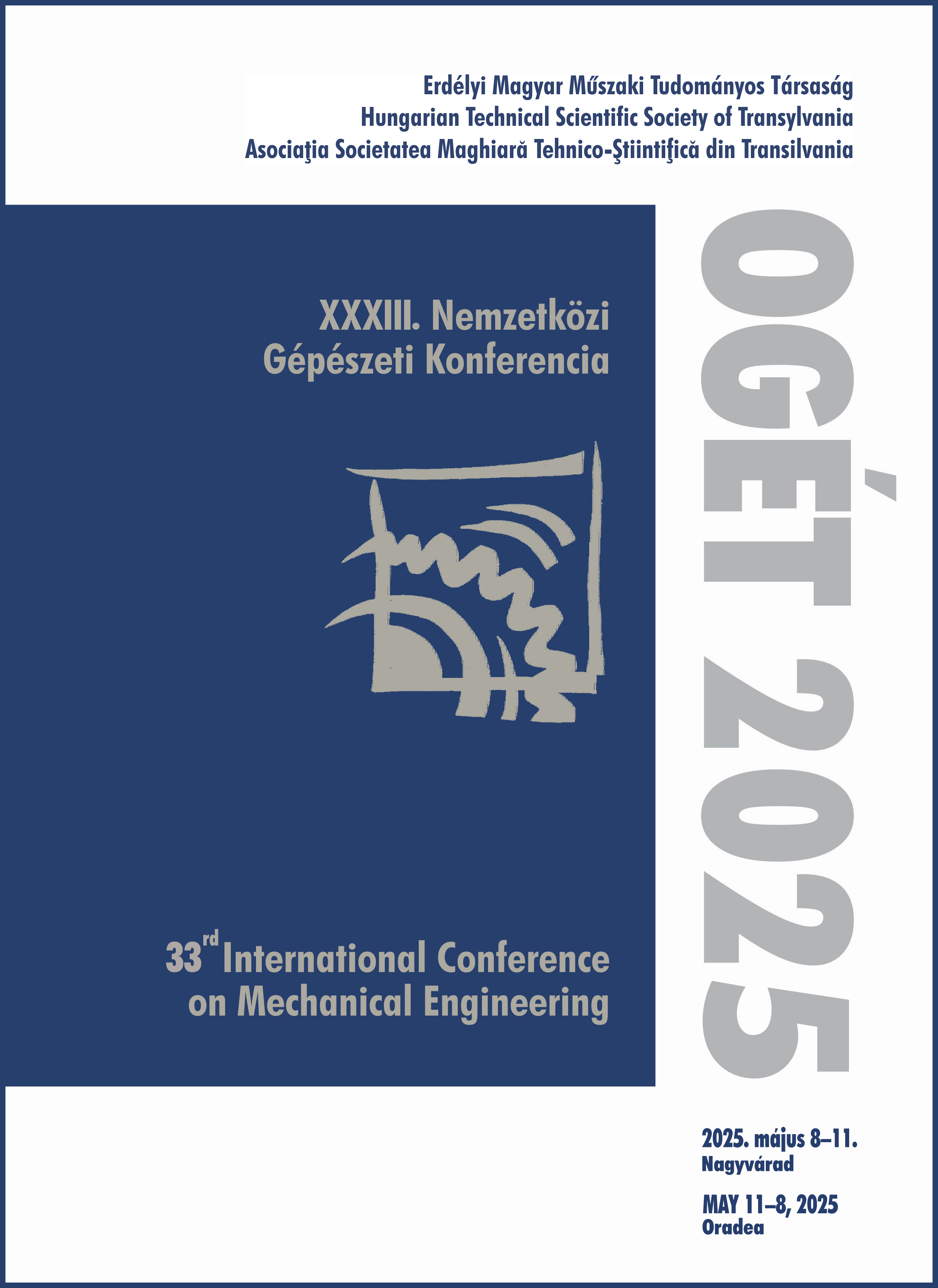Lankford-féle szám és az alakítási határdiagram kapcsolata
Relationship between the Lankford number and the transformation limit diagram
Keywords:
formabilitty, forming limit diagram, r-value, rolled steel sheets, anisotropy, /, alakíthatóság, alakítási határdiagram, r-érték, hengerelt acéllemezek, anizotrópiaAbstract
Our research aims to examine the effect of one of the characteristic properties of thin sheets, the r-value, on formability. In our article, we express formability using the material's forming limit diagram (FLD). FLDs typically describe the stretchability of sheet materials, and from the Lillet diagram, it is known that in this case, the limiting uniform strain (or the theoretically corresponding Nádai's n hardening exponent) measured during tensile tests is the key mechanical property. However, the r-value can significantly influence the deformation paths during stretching, which may even lead to changes in stretchability. In our research, we compared the calculated forming limit diagrams of a DP800 material with a typically low r-value and a DC04 material with a typically high r-value to make the effect of the r-value on the calculations visible. Based on the results calculated using the Swift and Stören-Rice theories, the n value is decisive when calculating the FLDs, whether assuming isotropic (Stören-Rice) material properties or considering anisotropy (Swift). For the material with a low r-value (DP800), this is the case. However, for the DC04 material, which has high anisotropy, we found that the effect of the n value on the forming limit curve is influenced by the higher r-value.
Kivonat
Kutatásunk célja a vékony lemezek egyik jellemző tulajdonságának, az r-értéknek az alakíthatóság tekintetében kifejtett hatásának a vizsgálata. Az alakíthatóságot cikkünkben az anyag alakítási határdiagramjával (FLC-vel) fejezzük ki. Az FLC-k jellemzően a lemezanyagok nyújthatóságáról számolnak be, és a Lillet-diagramból ismert, hogy ez esetben elsősorban a szakítóvizsgálatokkor mérhető egyenletes nyúlás határa (avagy az ezzel teoretikusan megegyező Nádai-féle n keményedési kitevő) a mérvadó mechanikai tulajdonság. Ugyanakkor, az r-érték a nyújtáskor fennálló alakváltozási utakat jelentősen képes befolyásolni, ami akár a nyújthatóság megváltozásához is vezethet. Kutatásunkban ezáltal egy átlagosan kis r-értékkel rendelkező DP800 és egy átlagosan nagy r-értékkel rendelkező DC04 lemezanyag számolt alakítási határdiagramjait vetettük össze, hogy láthatóvá váljon az r-étéknek a számításokra gyakorolt hatása. A Swift és a Stören-Rice elméletekkel számolt eredményeink alapján az n érték a mérvadó akár izotróp (Stören-Rice) anyagtulajdonságokat feltételező, akár az anizotrópiát is figyelembe vevő (Swift) elmélet alapján számoljuk az FLC-ket, a kis r értékű anyagnál (DP800). A nagy anizotrópiával rendelkező DC04 anyag esetében azonban azt találtuk, hogy az n érték hatását az alakítási határgörbére befolyásolja a nagyobb r-érték.
References
Kleemola H. J. and Kumpulainen J. O., “Journal of Mechanical Working Technology,” vol. 3, 1980.
H. Gao, O. El Fakir, L. Wang, D. J. Politis, and Z. Li, “Forming limit prediction for hot stamping processes featuring non-isothermal and complex loading conditions,” Int J Mech Sci, vol. 131–132, pp. 792–810, Oct. 2017, doi: 10.1016/J.IJMECSCI.2017.07.043.
S. Bagherzadeh, M. J. Mirnia, and B. Mollaei Dariani, “Numerical and experimental investigations of hydro-mechanical deep drawing process of laminated aluminum/steel sheets,” J Manuf Process, vol. 18, pp. 131–140, Apr. 2015, doi: 10.1016/J.JMAPRO.2015.03.004.
B. Ma, K. Diao, X. Wu, X. Li, M. Wan, and Z. Cai, “The effect of the through-thickness normal stress on sheet formability,” J Manuf Process, vol. 21, pp. 134–140, Jan. 2016, doi: 10.1016/J.JMAPRO.2015.12.006.
Keeler S. P. and Backofen W. A, “Trans. ASM 56,” pp. 25–48, 1963.
Gorton M. Goodwin, “Application of Strain Analysis to Sheet Metal Forming Problems in the Press Shop on JSTOR,” SAE Transactions, vol. 77, 1968, Accessed: Sep. 29, 2024. [Online]. Available: https://www.jstor.org/stable/44565070
J. E. Hockett and O. D. Sherby, “Large strain deformation of polycrystalline metals at low homologous temperatures,” J Mech Phys Solids, vol. 23, no. 2, pp. 87–98, Apr. 1975, doi: 10.1016/0022-5096(75)90018-6.
F. Barlat and K. Lian, “Plastic behavior and stretchability of sheet metals. Part I: A yield function for orthotropic sheets under plane stress conditions,” Int J Plast, vol. 5, no. 1, pp. 51–66, Jan. 1989, doi: 10.1016/0749-6419(89)90019-3.
C. L. Chow, M. Jie, and S. J. Hu, “Forming limit analysis of sheet metals based on a generalized deformation theory,” J Eng Mater Technol, vol. 125, no. 3, pp. 260–265, 2003, doi: 10.1115/1.1586938.
“Predictive model of FLC (Arcelor model) upgraded to UHSS steels | IDDRG.” Accessed: Jan. 17, 2025. [Online]. Available: https://iddrg.com/download/predictive-model-of-flc-arcelor-model-upgraded-to-uhss-steels/
M. Merklein, A. Kuppert, and M. Geiger, “Time dependent determination of forming limit diagrams,” CIRP Annals, vol. 59, no. 1, pp. 295–298, Jan. 2010, doi: 10.1016/J.CIRP.2010.03.001.
Stuart P. Keeler, “Determination of Forming Limits in Automotive Stampings,” SAE Transactions, vol. 75, 1966.
S. Stören and J. R. Rice, “Localized necking in thin sheets,” J Mech Phys Solids, vol. 23, no. 6, pp. 421–441, Dec. 1975, doi: 10.1016/0022-5096(75)90004-6.
“MSZ-EN-12004-2.”
T. Miklós, “Járműipari acélfejlesztések,” A Gépipari tudományos egyesület műszaki folyóirata, pp. 3–10, 2012.


